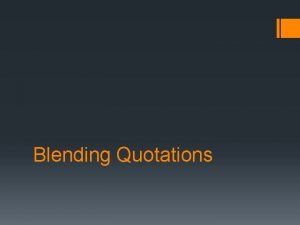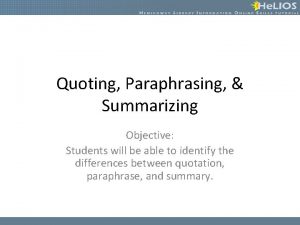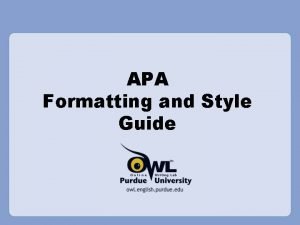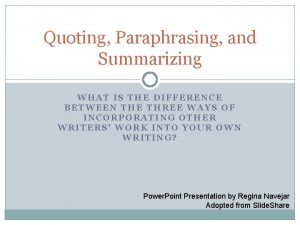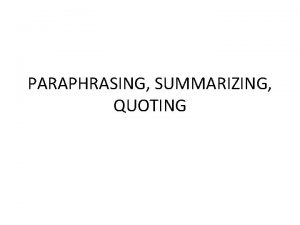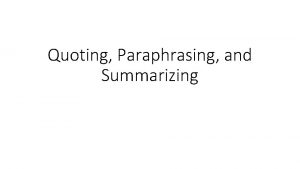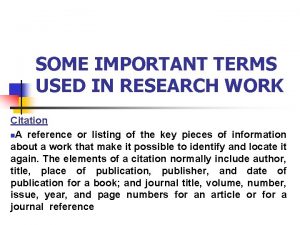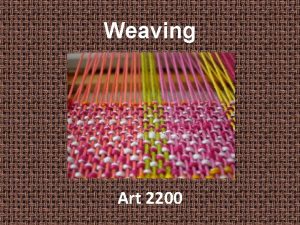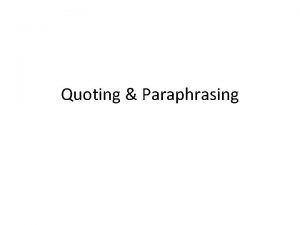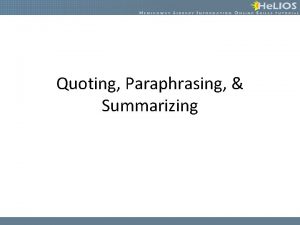Integrating Quotations What is quoting Weaving someone elses













- Slides: 13

Integrating Quotations

• What is quoting? – Weaving someone else’s words into your text • Use quotes that support the point you want to make • Make sure you clearly state YOUR point and how this quote helps – Need to reproduce exactly • Can omit unnecessary content with ellipses (NFG 411) • Make it fit smoothly into your text using brackets (NFG 412)

Don’t Float Your Quotes • Effectively incorporating quotes into writing can be tough. • Sometimes writers leave quotes “floating” or unattached to a sentence which causes confusion and usually results in a loss of meaning.

Don’t Float Your Quotes • Sometimes writers just shove a quote in the paper without giving it content: – What is this quote proving? – Why is it important/supportive of your claim?

Don’t Float Your Quotes • Here are three strategies to help you better incorporate quotes into a paper instead of leaving them floating:

Don’t Float Your Quotes • Method 1: Identify the speaker of the dialogue before the quotation. – The king sadly emits, “He was my closest counselor, he was keeper of my thoughts …. Men of birth and merit all should be as Ashhere was!” (78).

Don’t Float Your Quotes • Method 2: Blend the text as if the words were already a natural part of your own sentence.

Don’t Float Your Quotes • Original: Another trait that exemplifies his virtue of loyalty is in a passage that states, “he had done nobly in his sovereign’s war” (11). This shows not only his physical brawn and strength but also his loyalty and beliefs toward God by going on the crusade.

Don’t Float Your Quotes • Revised: Not only has the Knight “done nobly in his sovereign’s war” proving his loyalty to both God and country, but also he dispels a myth that all brawny warriors prefer killing to traveling on pilgrimages (11).

Don’t Float Your Quotes • Original: The Friar doesn’t like to hang out with the peasants. This is shown in the quote, “nothing good can come of commerce with such slum-and-gutter dwellers” (169). • Revised: The Friar makes it clear he does not like to associate with the peasants, claiming “nothing good can come of commerce with such slum-and-gutter dwellers” (169).

Don’t Float Your Quotes • Method 3: Use a colon. The sentence that precedes the colon explains the writer’s point; what follows is his evidence.

Don’t Float Your Quotes • Example: By excluding himself from humanity and working with incredible devotion, Frankenstein discovers how to generate life: “I pursued knowledge to her hiding places…[and] I became myself capable of bestowing animation upon lifeless matter” (50).

Don’t Float Your Quotes • Example: This violation of nature is also evident in the monster’s horrible inhuman countenance: “His watery eyes seemed almost of the same color as the dun-white sockets in which they were set…Oh! no mortal could support the horror of that countenance” (56).
 Managing someone elses money
Managing someone elses money Blending quotations
Blending quotations Cartoon by david low 1933
Cartoon by david low 1933 Quoting, paraphrasing and summarizing examples
Quoting, paraphrasing and summarizing examples Ice introduce cite explain
Ice introduce cite explain How to quote a play in an essay mla
How to quote a play in an essay mla 4-2 reading quoting paraphrasing and summarizing
4-2 reading quoting paraphrasing and summarizing Apa citation format multiple authors
Apa citation format multiple authors Compare paraphrasing summarizing and direct quoting
Compare paraphrasing summarizing and direct quoting Ice method examples
Ice method examples Try to practice paraphrasing summarizing and direct quoting
Try to practice paraphrasing summarizing and direct quoting Quoting summarizing and paraphrasing
Quoting summarizing and paraphrasing Quote analysis sentence starters
Quote analysis sentence starters How to cite multiple authors
How to cite multiple authors

